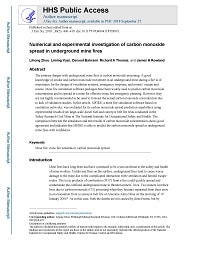Mining Publication: Numerical and Experimental Investigation of Carbon Monoxide Spread in Underground Mine Fires
Original creation date: September 2018
Authors: L Zhou, L Yuan, D Bahrami Hasanabadi, R Thomas, J Rowland
The primary danger with underground mine fires is carbon monoxide poisoning. A good knowledge of smoke and carbon monoxide movement in an underground mine during a fire is of importance for the design of ventilation systems, emergency response, and miners’ escape and rescue. Mine fire simulation software packages have been widely used to predict carbon monoxide concentration and its spread in a mine for effective mine fire emergency planning. However, they are not highly recommended to be used to forecast the actual carbon monoxide concentration due to lack of validation studies. In this article, MFIRE, a mine fire simulation software based on ventilation networks, was evaluated for its carbon monoxide spread prediction capabilities using experimental results from large-scale diesel fuel and conveyor belt fire tests conducted in the Safety Research Coal Mine at The National Institute for Occupational Safety and Health. The comparison between the simulation and test results of carbon monoxide concentration shows good agreement and indicates that MFIRE is able to predict the carbon monoxide spread in underground mine fires with confidence.

- CFD Modeling of Fire Spread Along Combustibles in a Mine Entry
- Evaluation of the Relative Importance of Coalbed Reservoir Parameters for Prediction of Methane Inflow Rates During Mining of Longwall Development Entries
- Experimental and Modeling Investigation of the Effect of Ventilation on Smoke Rollback in a Mine Entry
- Factors Affecting ANFO Fumes Production
- Modeling and Data Analysis of 50 to 5000 kHz Radio Wave Propagation in Coal Mines
- Monitoring and Removal of CO in Blasting Operations
- Reservoir Engineering Considerations for Coal Seam Degasification and Methane Control in Underground Mines
- Smoke, Carbon Monoxide, and Hydrogen Chloride Production from the Pyrolysis of Conveyor Belting and Brattice Cloth
- Theoretical Noise and Propagation Models for Through-the-earth Communication
- Variation of Horizontal Stresses and Strains in Mines in Bedded Deposits in the Eastern and Midwestern United States